Montessori and Steiner Philosophy Pioneered Child-directed Learning in the Early Years and Alternative Education
Their two respective philosophies described briefly in the following chart embrace their own approaches to facilitating a natural appreciation of the young child’s natural play and learn disposition.
| Steiner philosophy
· Freedom within a structured environment · Complete unity of the body, soul and spirit · Natural rhythms and sensorial experiences from daily life · Inner spiritual forces facilitate that the child’s imitative response · Entirely individual artistic impulses unfolding their own soul activity. · ‘The art of education must proceed from life itself and not from abstract scientific thought’ (Steiner, 1988:5) · We must protect the child from being absorbed too strongly or too rapidly by the outer world.(Steiner,1982:29,46,47) |
Montessori Philosophy · Each child has cycles of activity · Freedom to choose to work through and complete activities without interruption. · An environment that illustrates the small steps within a learning goal. · Didactic materials for sensory differentiation and discernment. · Steiner emphasizes the balance in teaching, which is listening and watching (that which comes inward from the outside) and the autonomous activities of doing(that which is anoutward expression from within). (Steiner,1982:35) · Montessori suggests that play and learning are the child’s work, and that “normalisation” through work is most likely to succeed between the ages of three and six years. |


Child development during the early years
Steiner and Montessori both emphasised that free play is very important for all aspects of children’s development. The chart below presents the different aspects of play and learning and the intrinsic relationship between freedom to play and child directed learning
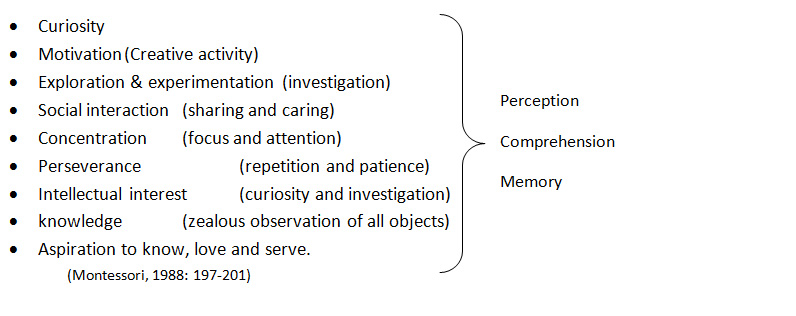
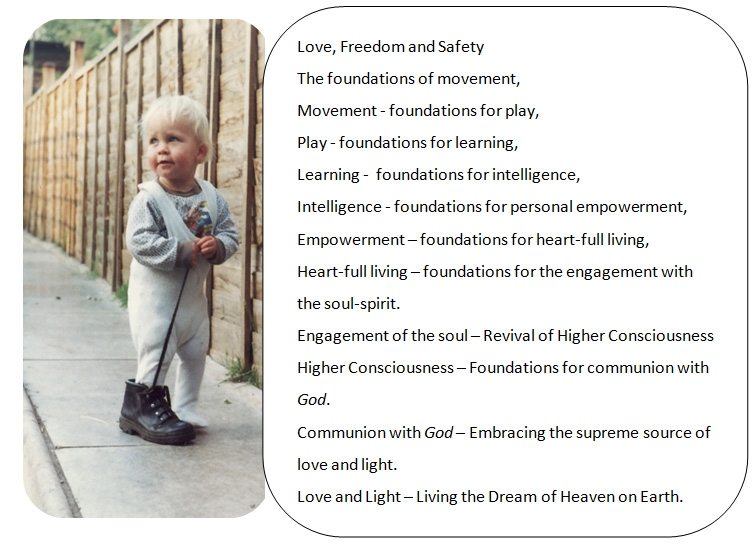
summary below describes what is thought to best facilitate children’s natural play and learning:-
– illustrate care, love and understanding
– leave a child undisturbed when he is engaged in concentrating on a chosen activity
– gives each child freedom to make his own plans, choices and decisions.
– illustrate by example how to do things, what different objects do, and what they are used for.
– provides a child friendly interesting learning environment.
– present difficult tasks broken down into small consequential, step by step actions
– gain a deep knowledge and understanding of the individual child’s personal qualities, passions, skills and temperament
The adult’s ability to facilitate or obstruct the child’s Social and environmental wellbeing requires the ability to find a balance that maintains harmony and encourages personal empowerment for example :-
- Enrichment versus over-stimulation
- Inspiring versus overwhelming
- Encouragement versus superiority
- Illustrating creativity versus authentic creative interaction
- Sharing versus entertainment
- Copied learning versus co-operative learning
- Sharing versus entertainment
- Illustrating creativity versus authentic creative interaction
- Encouragement versus superiority
- Inspiring versus overwhelming
The skills related to the above and a person’s ability to scaffold a child’s natural learning potential are directly related to a conscious understanding or intuitive perception of what Vygotsky describes as the child’s Zone of Proximal Development.
- Learning as a three period lesson.
This appears as part of the Steiner lessons and is organically incorporated within the following Steiner method:-
- The first lesson-involves a multisensory presentation of information. In the first period presents new language and vocabulary which is provided in association with concrete sensory experience.
- The second lesson involves the opportunity to explore and personalise awareness through experiential experience, self-directed interaction and exploration. In the second period thenew vocabulary is uses to indicate meaningful communication.
- The third lesson provides opportunities for creative expression and integration with previous learning. This lesson can illustrate that the new vocabularyhas been successfully internalised and can be used appropriately. This third lesson often extends understanding and learning through recall, questions, personal enquiry, and creative integration with previous learning.

Abstract & Concrete Thinking
The following diagram has been designed by the author to illustrates her own understanding of associated areas of abstract and concrete development. It is important that everyone and especially children are encouraged to integrate functions in the brain in a balanced way that promotes more complex areas of learning and appropriate responses.
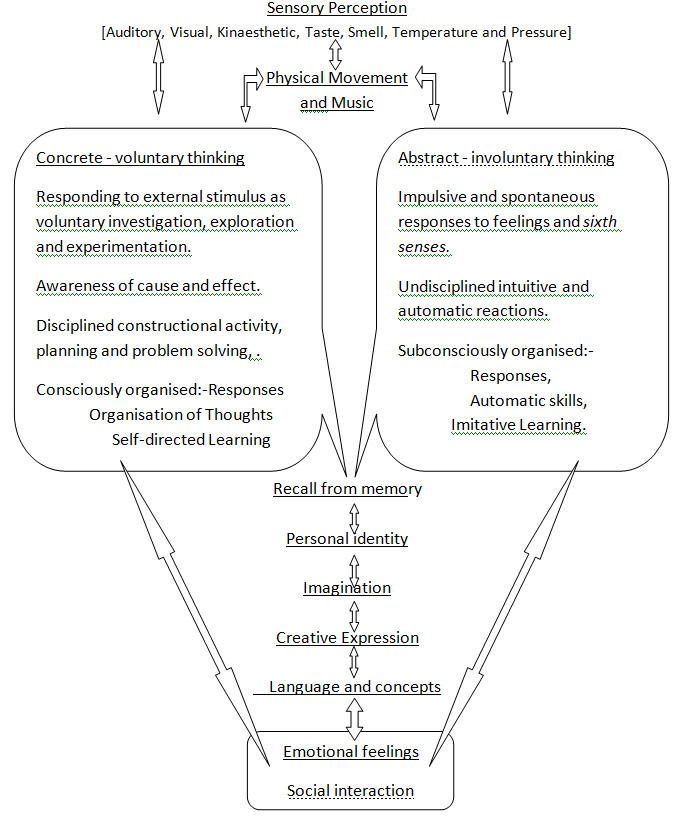
Creativity as a union of environmental activity with feelings,
uniting fantasy with reality and facilitating the embodiment of joy described as enjoyment.
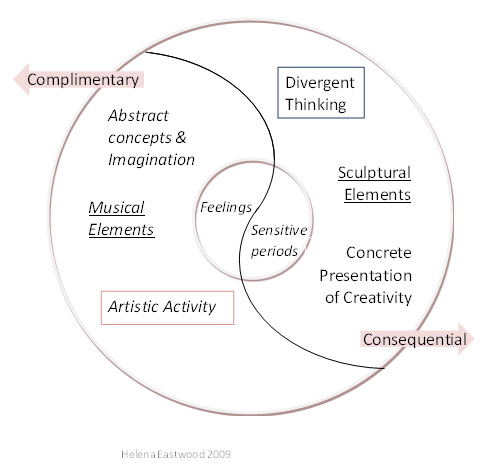
The contrasting lists below illustrate two types of thinkingwhich the author describes as abstract and concrete; Steiner describes as ‘the musical elements’ and ‘the sculptural elements’ (Steiner,1982:52)and Fisher describes as ‘a division between creative or exploratory thinking and critical or logically analytical reasoning’.
‘Creative———————————-critical
Exploratory——————————analytical
Inductive——————————-deductive
Hypothesis forming—————-hypothesis testing
Informal thinking——————-formal thinking
Adventurous thinking————–closed thinking(Bartlett)
Left-handed Thinking————-right-handed Thinking(Bruner)
Divergent thinking———–convergent thinking(Guildford)
Lateral thinking—————vertical thinking(De Bono)’ (Fisher, 1990:32)
Supporting Children’s Creativity and Creative thinking
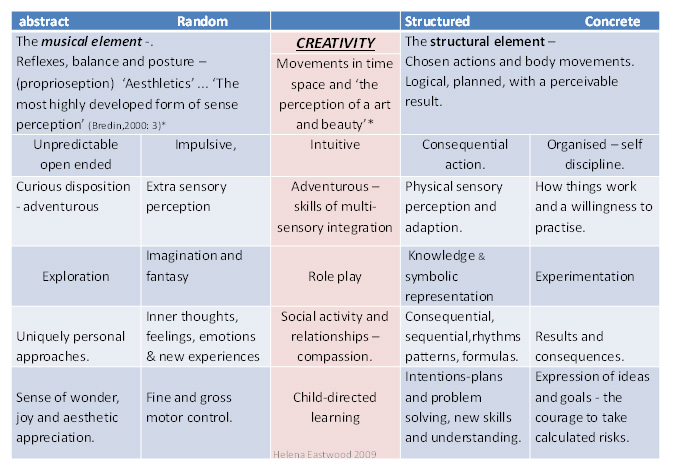
Supporting Children’s Creativity and Creative thinking is acknowledged in the list of recommendations below:-
|
|
Integration of Concrete and Abstract Perspectives
Supporting enhanced creativity and self-directed learning.
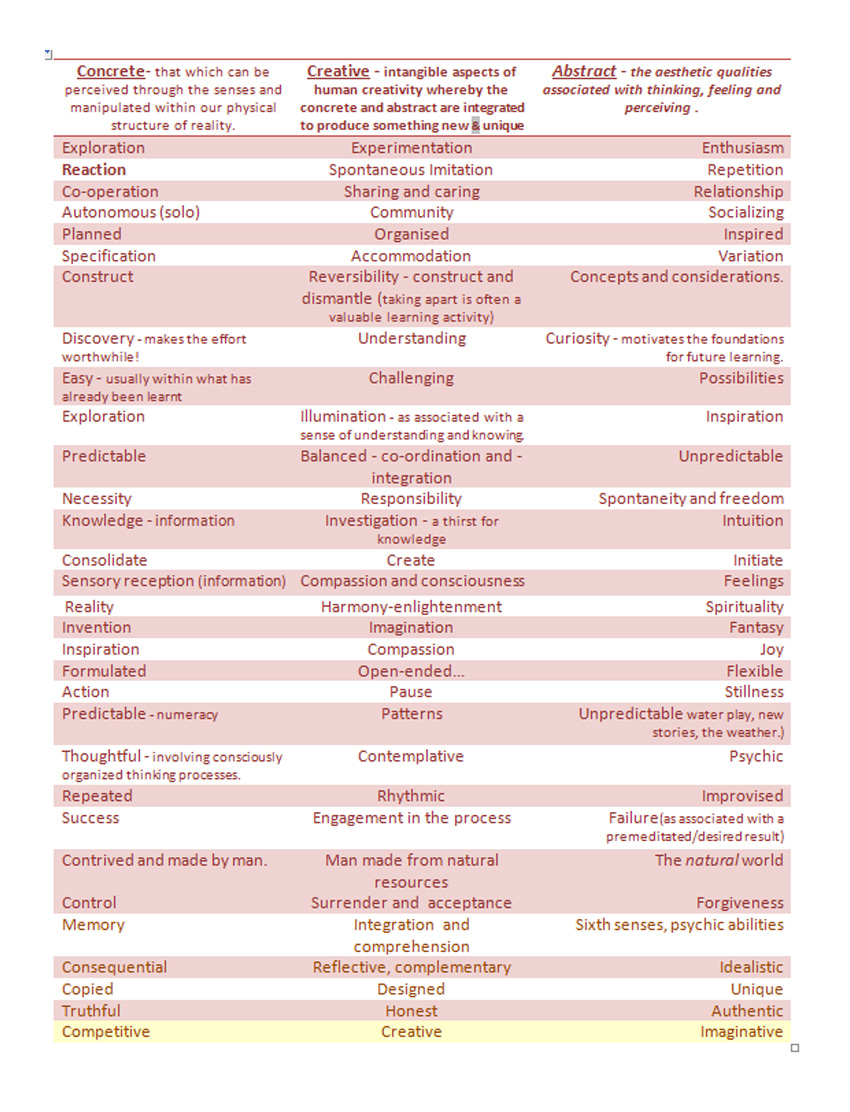
A good directive for adults wishing to support creative endeavours is
Simplify –For example:-
MAKE IT BIGGER
Outdoor activities -v- indoor activities e.g. at the stream -v- indoor water play; maypole dancing –v- sewing and table top weaving activities.
Make it slower…..-
| ‘With assistance, every child can do more than he can by himself – though only within the limits set by the state of his development.’ (Vygotsky,1986: 187) |
E.g. Badminton –v- tennis
Prioritise focus on a specific aspect of the skill.
e.g. Painting with prime colours on wet paper to make secondary colours.
Enrich the experience with diversity and/or a multisensory approach.
E.g. Supporting an area of interest with a suitable project and/or special outing.
Enhance motivation –within the context of useful skills, the child’s interests and abilities (scaffolding), personality and disposition.
Provide reflection and open ended questions
i.e.Questioning the question; identify successful activity with appropriate positive feedback and encouragement.
Encourage the child to lead/direct every aspect of the adult’s interaction and participation. Listen to every aspect of the child’s verbal and non-verbal communication.
